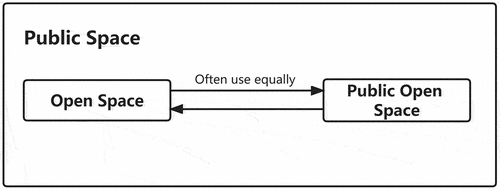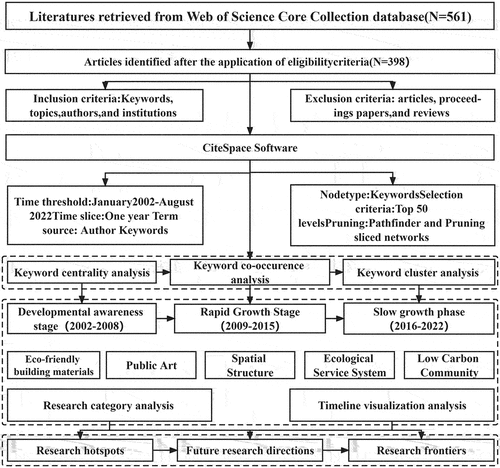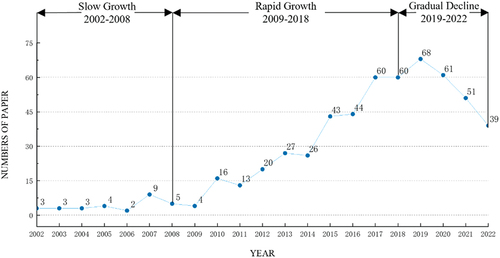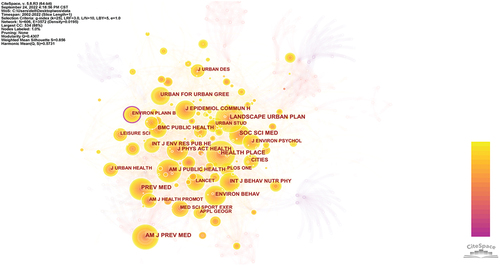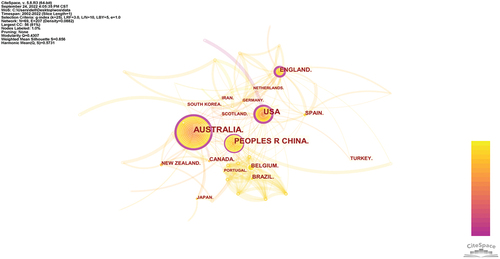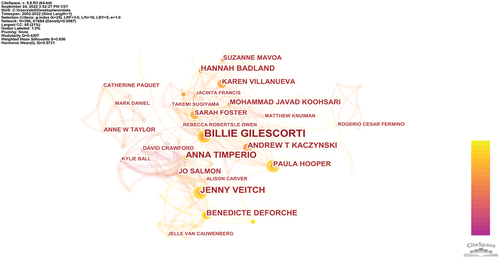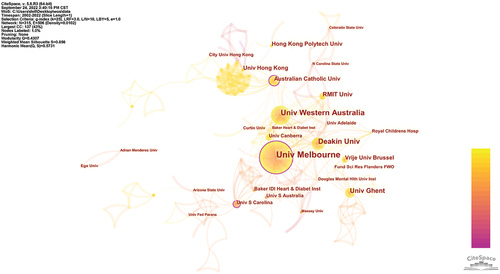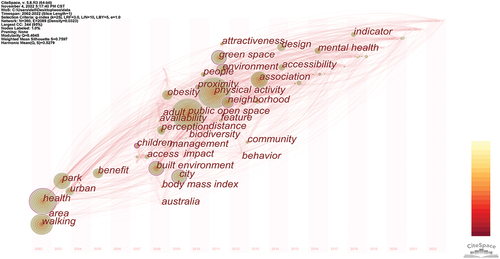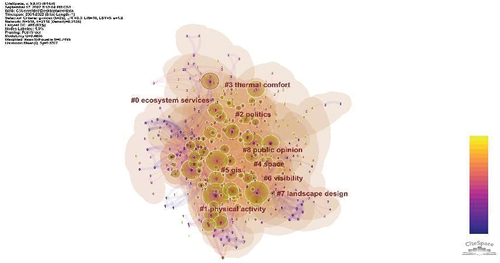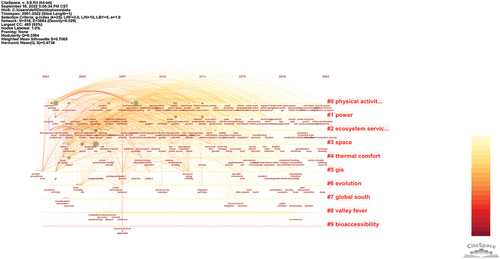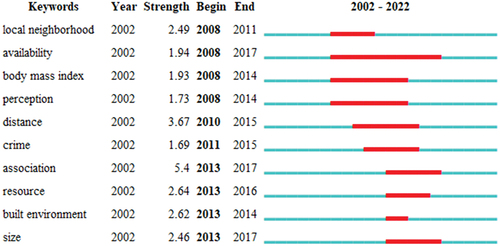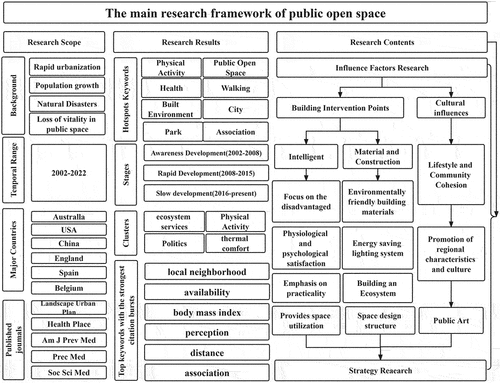ABSTRACT
Urbanization is essential for human development and progress. Therefore, it is urgent to study urban public open space (POS) under the dual impact of urbanization construction and the global COVID-19 outbreak. Bibliometric visual analysis is currently popular in academia, as it can be used to analyze specific fields. This research summarizes the development history, hotspots, and trends in POS, with theoretical and data support based on the Web of Science (WoS) Core Collection. The study period was from 2002 to 2022. A total of 398 papers were collected, with the number of papers increasing over time. The research covers various fields, including environment, architecture, ecology, geography, design, behavior, etc. The results show that POS research hotspots include form layout, social value, and sustainable renewal. This paper demonstrates that there is a lack of vitality in urban POS. Although affected by the COVID-19 pandemic, the fundamental reason for this is that the vitality of POS is not created from multiple dimensions. Vitality should be enhanced according to the space’s terrain, ecology, environment, and other factors. POS research lacks crossdisciplinary collaboration and the fusion of multiple fields. Thus, cooperation between the various disciplines involved must be strengthened. In the future, POS research should change its design concept, continue to place the “human” in the leading position, establish a multidisciplinary research system, use local empirical cases, and develop applicable theories that can be extended upon. Thus, it will be possible to build harmonious open spaces that enhance the relationship between the people and the land and provide practical solutions for other countries in which urbanization is advancing.
1. Introduction
In the newly released World Cities Report 2022: A Vision for the Future of Cities, UN-Habitat pointed out that the COVID-19 pandemic temporarily delayed the rapid global urbanization process and that the growth of the global urban population is back on track, with the population estimated to increase by 2.2 billion by 2050, i.e., that is 68 percent of the population, up from 56 percent in 2021 (Citaristi Citation2022). Rapid urbanization has promoted the transformation of urban planning and highlighted the need for space resources (Zhao et al. Citation2016; Deng et al. Citation2020). For countries with high levels of urbanization and rapid urban population growth, problems such as POS planning have become important issues. These must be considered in order to strengthen responses to relatively low POS ratios and poor levels of sustainable development caused by dense urban populations (Ritchie and Roser Citation2018). POS planning and other issues, for example, those related to environmental problems, housing problems, traffic problems, should be considered in countries with rapid urbanization. In the process of urbanization growth, traffic congestion, lack of resources, environmental pollution, and other problems should be considered and addressed (Broere Citation2016). A compound POS theory should be established and redesigned to meet people’s daily needs in line with the requirements of urban regional culture (Ma et al. Citation2022). POS research has become one of the most popular urban research fields in academia. POS is important for residents’ recreation, health, social communication, and urban quality improvement (Zhu et al. Citation2017). From the parks and POSs in ancient Mesopotamia’s Sumerian period, to the urban and rural gardens in ancient Rome, and from the idyllic 19th century city of Howard, to Olmsted’s Central Park in New York, human beings have always pursued harmonious POSs that connect man and land (Anqi, Cenci, and Zhang Citation2022; Zhu et al. Citation2022). However, the acceleration of urbanization has put pressure on the environment, and the uneven distribution of the population has affected open space resources (Chen, Liu, and Lu Citation2016). As a result of the COVID-19 pandemic and the associated lack of outdoor activities, people’s mood and health were significantly affected and the prevalence of mental illness increased (Takiguchi et al. Citation2023). These factors helped to accelerate open space replanning and form a perfect open space control system. To this end, the visual analysis of POS will provide practical methods and reference significance for many countries.
As a result of the COVID-19 pandemic, the current definition of POS may need to be reconsidered. For example, as a result of the restrictions on indoor gatherings, many businesses converted restaurant parking lots into a restaurants, nucleic acid testing was conducted in the park, and movies were played in playgrounds, etc (Sax Citation2018; Meeks and Murphy Citation2016). These unusual behaviors made us rethink the definition of POS. For example, the Chinese government formulated the general policy of dynamic zero clearing and regulations to control the flow of the population (Zhou et al. Citation2020) in which people required a valid nucleic acid test to enter public places. These POS-related activities, which did not exist before the COVID-19 pandemic, are unusual. In the existing research on public space planning, a great deal of attention is paid to urban design at the microlevel, and there is a lack of macroresearch on POS (Hongguo, Xiaoyu, and Yuchen Citation2022; Wang, Yung, and Sun Citation2022; Korani and Shafiei Citation2022). Countries around the world have established rational public space development systems, which are essential to guiding the development of POSs, as a means of coping with urbanization.
The promulgation of the Metropolitan Open Space Law in London in 1877 marked the emergence of the modern open space (Eisenman Citation2013). Open space can refer to public or private land use; thus, the concept of open space is broader than the concept of “POS” (Nikolaidou et al. Citation2016). Nevertheless, they are often used interchangeably in practice, and open space is sometimes used to specifically refer to POS (Francis et al. Citation2012). From the perspective of public goods, urban POS is a place and space created and maintained by public power for the use and enjoyment of all citizens. It has the characteristics of both a public space and an open space. It is an open space in the city that is open to the public to some extent (Low, Taplin, and Scheld Citation2009).
In 2002, the E.U. adopted “Environment 2010: Our Future, Our Choice”, which outlined a set of environmental development goals for the subsequent 10 years (Negrea et al. Citation2006). This policy proposed to achieve a high level of protection based on the consideration of regional differences and included four priority planning principles: 1. Climate change; 2. Conservation of nature and biodiversity; 3. Environment and health; 4. Improvement of sustainable use of natural resources and management of services. This policy brought the sustainable development of the space environment into the spotlight as a major research theme. In turn, POS research became central.
In 2002, the development of the POS sector was boosted by the introduction of the E.U. Environmental Programme. The details of the related documents are shown in (Reimer, Getimis, and Blotevogel Citation2014; Thompson and Maginn Citation2012; Nadin and Stead Citation2008).
Table 1. Typical spatial planning policies in POS.
“Carbon neutrality” is located in the exploration and application phase of efforts (Wang et al. Citation2021). Considering the current social background in particular, how to establish a complete research system to optimize and adjust the scale and layout of open space under the influence of “Carbon neutrality” development and “COVID-19” (Hepburn et al. Citation2021) is vital for the sustainable development of humanity. Therefore, by identifying and analyzing POS trends, the basic elements and keywords related to public space were determined. In addition, CiteSpace analyzed the research trends and other hot issues in this field. This paper puts forward various concepts, such as future optimization, the further expansion of the research direction and overall framework, and the basis and suggestions for public space research, all of which provide guidance and practical experience. We can confirm that our hotspot analysis of public space differs from that of previous research. On the basis of previous research, providing new ideas and coping methods is both an important subject and keyword for research and development.
This paper discusses the concept, research significance, and future development direction of POS theory, mainly from three aspects: a review of global POS development; an analysis and exposition of the emergent keywords, research direction, and future research hotspots related to POS based on data visualization; research prospects in the post-COVID-19 period and how to establish compound POS.
This paper is structured as follows: the first part introduces the data sources and research methods. The second part analyzes the related public space policies and provides the case for POS. Then, according to the number of published papers, published author cooperation, published journals, publication cooperation distribution, and research institutions are reviewed. Then, for the most influential categories in the research field, highly cited articles and literature are listed for analysis and summary. We obtained the latest research hotspot and future research directions by analyzing the keywords. Finally, this paper discusses the future research hotspots, evolution, and prospects.
2. Data sources and research methods
2.1. Data sources
To apply a bibliometric analysis to POS, the first step was to select the database. In this study, we chose the WOS platform as the database.
In 1997, Thomson integrated SCI, SSCI, and AHCI in order to use the open internet environment to create an online version of the multidisciplinary literature database, which is known as the Web of Science (Zhang et al. Citation2020). The database includes a variety of other databases and more than 20,000 high-impact academic journals and conference documents of global importance, covering many fields such as natural science, art, and humanities. Its authority and scientificity make it an objective and reliable basis for research. Moreover, this database is one of the most authoritative and popular for conducting scientific research (Zhu, Koutra, and Zhang Citation2022), which is why we chose to use it.
The second step was to select the keywords. The research theme explores POS under the background of achieving sustainable development and rural revitalization. In 2002, the E.U. adopted the Sixth Environmental Action Programme entitled “Environment 2010: Our Future, Our Choice” (2002–2012). Therefore, the data collection period was from January 2002 to September 2022. The plan consists of eight chapters, which mainly define the objectives, implementation principles, and priority areas of E.U. environmental policy for the subsequent 10 years. The proposals in this plan promoted the development of the POS field. This paper selected research results from nearly 20 years, i.e., from 2002 to 2022, for the visual analysis.
The related concepts of public space include open space, POS, and green space, which are closely related but have some differences (Francis et al. Citation2012). In this paper, POS was selected as the keyword in the WoS core set for retrieval. Sometimes, POS and public space are used equally in practical applications, but “POS” is more targeted (Francis et al. Citation2012). The previous studies on POS did not explain the difference between POS and public space (PS). The specific relationship is shown in . In this paper, “Topic” was selected as the retrieval type to retrieve the title, abstract, author, and keywords from the WoS core set.
2.2. Research methods
CiteSpace is a scientific bibliometric analysis tool for literature reviews. It is a knowledge mapping software for visualizing information based on the Java platform, presenting the structure, laws, and distribution scientific knowledge through a visual analysis. In hot topic research, emerging cutting-edge topic identification is very useful (Wu et al. Citation2022). The resulting graph is called a “knowledge graph” or “bibliometric map”. In this research, CiteSpace 5.8R3 was used to obtain 561 articles. Through screening and sorting, 398 effective pieces of literature were obtained for analysis by eliminating reviews, book chapters, news, and other types of literature. The visualization analysis was conducted by analyzing the publications, keywords, research institutions, authors, and authors’ countries in the 398 articles related to POS. Through scientific analysis, the research progress of public space is discussed.
In this paper, the relationship charts show different fields obtained via CiteSpace from 2002 to 2022. In the current research, we took POS as the keyword and assessed POS as the search term. Many keywords frequently appeared in 2002, but the research in this period mainly focused on the themes of “health” and “rest”. The time slice was set to 1 year and the other settings were left unchanged by default. Key information such as keywords, authors, paper countries, research institutions, and published journals were selected and analyzed. Through the analysis of the relationship between each topic’s information, the development status was obtained, showing the development trend of POS from 2002 to 2022, and predicting the general direction of the future development of public space research.
The core focus of new POS research is to establish a POS system that can satisfy residents and tourists and express the local cultural characteristics. We retrieved “Public Open Space” and “Public Open Spaces” on 22 September 2022. In the WoS core collection, TS= “Public Open Space” OR “Public Open Spaces”. These records were exported in “plain text” format and “full records with cited references”. Then, the CiteSpace 5.8R3 software was imported for analysis. The research design process is shown in .
3. Results
3.1. Results by data collection
3.1.1. Number of publications
The number of publications is an important indicator of the development of the field, and the number of publications in each country directly indicates which country’s researchers pay more attention to the field (Wang, Huang, and Li Citation2022).
According to the WOS data collection, at the time of the original collection, Australia (114), the United States (76), and China (67) had published the most research papers on POS, followed by the United Kingdom (28), Spain (21), Belgium (21), and Canada (20). From 1997 to 2022, public open space publication went through three stages: slow growth (2002–2008), rapid growth (2009–2018), and gradual decline (2019–2022), as shown in .
The change in the number of publications is an essential indicator of the development of the field studied. We obtained 398 articles on POS by screening for the annual publication of articles, general analyses, research, and development in 2002–2022. The development of POS has experienced three stages: Slow development, rapid development, and gradual decline.
Slow development
In 1997 and 1999, public space policies were introduced (), but the research intensity was low during this period. People began to study the POS field in 2002. The number of publications developed steadily between 2002 and 2008.
Rapid development
From 2009 to 2018, research on POS increased significantly, reaching its peak in 2019. During this period, various countries introduced planning policies on POS, dramatically promoting people’s enthusiasm for research in this field. According to the CiteSpace analysis, Australia published the most papers in this field. This paper found that the publication of Planning Adelaide in 2016 facilitated the emergence of many studies.
Gradual decline
From 2019 to 2022, research on public space tended to be less popular compared with the second stage. In the second phase, as urbanization in most countries was rapidly developing, the proposal of core human ideas increased academic POS research. However, since the COVID-19 pandemic, the academic focus has shifted, and the POS research field has brought forth new implications.
With the intensive research on ecological sustainability and the epidemic restricting people’s travel in recent years, the research on POS gradually gained interest. This will allow POS to rapidly develop into a mature field, establish a sound system, and provide practical assistance to other countries. However, all research has a lag, and article publishing takes time. This paper predicts that the number of articles in this field will grow again in the coming years.
3.1.2. Major journal analysis
The analysis of major journals can be used to assess which journals play a key role in the development process of the POS field and provide directions for subsequent research findings (Vogel Citation2012).
The node type was set to the cited journal, and the time slice was set to 1 year to generate a map of co-cited journals. In the CiteSpace analysis, the number of nodes in the journal distribution was 606, the connection value was 3572, and the density was 0.0195. As shown in , the top five most cited journals were Landscape Urban Plan (ISSN 0169–2046), Health Place (ISSN 1353–8292), American Journal of Preventive Medicine (ISSN 0749–3797), Preventive Medicine (ISSN 0091–7435), and Social Science Medicine (ISSN 0277–9536), with more than 150 articles overall. In terms of centrality, the top five most influential journals were Urban Studies (0.1), American Journal of Health Promotion (0.1), Environment and Planning B-Planning & Design (0.1), Journal of the American Planning Association (0.09), and American Journal of Preventive Medicine (0.08).
Table 2. Major journals in POS, 2002–2022.
Regarding the main research directions in this research field, as shown in , POS is an important factor in the urban system, which cannot exist independently from the environment. The research into public development space directly and indirectly affects the fields of ecology, environment, biology, health science, etc.
3.1.3. Major regions analysis
On the basis of the analysis of the distribution of regional cooperation in publications, the cross-cooperation of major countries in the research field and the importance and influence of countries in POS research can be understood. This can be used to provide possible research directions and topics for in-depth research in this field (Wu et al. Citation2021).
CiteSpace was used to analyze the distribution of cooperation in POS research. We found that the field contained 207 connection values, 69 nodes, and has a density of 0.0882. The main diagram is shown in . From 2002 to 2022, 114 papers were published by scholars at research institutes in Australia, 76 in the United States, and 67 in China.
As shown in , the United Kingdom’s publication volume ranked fourth, and the number of references cooperating with other countries was the largest, with a value of 0.36. For more information, details are shown in . Germany cooperated closely with China, the United Kingdom, the United States, and Canada. There was a lack of cooperation and exchange between Japan, Turkey, and other countries. If the status quo can be changed, strengthening cooperation among countries will promote the globalization of the research field, thus bringing significant research progress. By 2022, Australia and the United States will have completed more than 80 percent of their urbanization process, while China and other developing countries are progressing fast (Tian and Wu Citation2015; Taylor Citation0000). Therefore, the current research status no longer meets the current development needs of POS; thus, many scholars have addressed the current urbanization problems.
Table 3. List of contributing countries and number of records contributed in POS, 2002–2022.
3.1.4. Authors’ cooperation distribution analysis
Through the analysis of the authors’ cooperation distribution, the cross-cooperation relationship in the field of POS and the direction of cooperation in the field of POS in the future can be obtained. Cross-cooperation with other researchers can provide directions for new research in the future.
On the basis of the CiteSpace analysis, key researchers in the research field and the collaboration and cross-reference relationships among researchers were identified. The academic research effects of various research groups can be found through their research, and relevant data can be collected and imported into CiteSpace. The Author Collaboration network map contains 396 nodes, 684 connections, and has a density of 0.0087. The principal authors and their institutions are detailed in .
Among the top five researchers with the highest number of publications, the top three were all from Australia (Billie Gilescorti (31), Anna Timperio (18), Jenny Veitch (16)), followed by Belgian researcher Benedicte Deforche (12), and American researcher Andrew T Kaczynski (11). According to the data analysis, seven of the top ten researchers were from Australia, among which three were from RMIT, and three were from Deakin University, indicating that this research institution engages in more discussions in the field of POS, as can be seen in . The analysis shows that the POS research field lacks an academic research team with core leadership skills. In the future, academia should strengthen cooperation between local scholars and conduct in-depth exchanges. In addition, as a result of this cooperation and in-depth study, a leading academic team should be formed in this field.
Table 4. Top 10 authors in POS in terms of volume of publications, 2002–2022.
3.1.5. Distribution of contributing institutions
By analyzing the distribution of collaboration among research institutions, insights into the recognition of academic support in the field were obtained, thus promoting collaboration among institutions. Cooperation between various research institutions promoted in-depth research in this field. The image produced by CiteSpace shows 315 nodes and 506 connection values, with a density of 0.0102. The knowledge map of the core organizations is shown in .
In terms of the number of articles published among the top 10 publishers from 2002 to 2022, the University of Melbourne ranked first (49 articles), the University of Western Australia ranked second (30), and Deakin University ranked third (26). In the top 10 research institution centrality rankings, the top three were University Melbourne (0.19), Australian Catholic University (0.15), and University Canberra (0.11). Centrality reflects the influence of an institution on a publication. The higher the centrality value, the more significant the impact on the publication. As can be seen from , the number of publications and the value of centrality were not the same. Although the number of publications was sometimes large, articles were not always high-quality, so the influence was insignificant. As seen in and , there was close cooperation among universities, research institutions, and companies in the field of POS research globally, which will further deepen our research.
Table 5. Contributing institutions by frequency and centrality in POS, 2002–2022.
Table 6. List of the most influential categories in POS, 2002–2022.
3.2. Research fields
Setting the node type to a category and the time slice to 1 year produced a collaborative relationship graph of disciplinary categories. Via the CiteSpace analysis, the knowledge graph was obtained, which has 129 nodes and 678 connection values. In the centrality display, the most influential Social Science Citation Index (SSCI) had a centrality of 0.57. Environmental Sciences and Ecology was the second most influential, with a centrality of 0.22. The centrality of Environmental Sciences was 0.13 and that of Urban Studies and Environmental Studies was 0.09. According to the analysis results, it can be seen that the influence of centrality was significant, especially SSCI, which presents a much higher fault-type growth than the other categories. lists the top 10 disciplines with the highest academic impact.
In , each node’s size represents the occurrence frequency. The outer purple boundary of a node represents influence, and the thicker the boundary, the greater the academic influence on the node. The thicker the purple circle, the larger the influence factor. The connecting lines between each circle represent connections to other academics, and the thicker the lines, the stronger the connections. The figure shows that the top disciplines in POS research were SSCI, Environmental Science and Ecology, Public, Environmental, and Occupational Health, Urban Studies, and Environmental Studies. Environmental studies had the greatest impact on POS. Influential subjects included environmental studies, public environment, occupational health, environmental science, urban studies, regional urban planning, geography, green and sustainable technology, engineering, civil engineering, etc. These disciplines were closely related to POS research. These data demonstrate POS research through visualization of interdisciplinary research. Cooperation among various disciplines will change with societal changes in the future development process. Academia should keep up with hot social development issues, conduct in-depth research in the POS field, and create POSs that satisfy the people. Therefore, the Social Science Citation Index plays an important role in this research field.
3.2.1. Highly cited articles
In the core set of WOS, we used POS as the keyword search to retrieve the cited articles, ranked from high to low according to the number of citations. Thus, was obtained. The most cited article was “Increasing walking – How important is the distance to, attractiveness, and size of POS?” (cited 950 times, 52.78 Impact Factor). The second most-cited paper was “Socioeconomic status differences in recreational physical activity levels and real and perceived access to a supportive physical environment” (cited 550 times, 26.19 Impact Factor). The third most-cited paper was “Urban open space in the 21st century” (cited 337 times, 16.05 Impact Factor). The main research directions of these three papers are public environment, occupational health, and environmental science and ecology, respectively. Details of other cited articles are shown in . According to the cited articles, it can be seen that the POS research field involves a wide range of disciplines. A combination of multidisciplinary research is needed to establish a perfect system and better meet the requirements of modern development. In POS, this paper found that articles with a high number of citations did not necessarily have high impact factors, indicating no direct correlation between the number of citations and the level of impact factors. The journal itself has a stronger influence than the article. The citation times of the article represent the academic vitality of the article. We can determine the most cutting-edge research direction and discipline through high attraction levels. On the basis of the relationship between the years of cited articles and the number of cited articles, we can determine future hot research directions in a research field and the latest research progress.
Table 7. Reference with strongest citation bursts in POS, 2002–2022.
3.3. Research hotspots and research strategies
3.3.1. Keyword co-occurrence network
Keyword co-occurrence is the co-occurrence analysis of selected keywords in the WOS dataset. Compared with the co-citation analysis, a keyword co-occurrence analysis can more intuitively display the POS’s hot content, topic distribution, and discipline structure, revealing the article’s main content, methods, and core ideas. The data were imported into the CiteSpace software, the time period from 2002 to 2022, the time slice was 1 year, the keywords were network nodes, and the keyword co-occurrence map of the POS was generated, as shown in .
The number of nodes in the map is 360, the connection value is 1366, and the density is 0.021. The node size represents the number of occurrences, and the connection value is the number of co-occurrences of the two keywords. The more occurrences, the thicker the line. Using the word frequency statistics from CiteSpace, 5 years were divided into four periods according to the year, and the first five keywords from 2002 to 2006 were extracted in order of frequency from high to low, as shown in . According to the statistical results, in the early stage of POS research, researchers often used health, walking, park, benefit, and urban as keywords, which were the core themes of POS research from 2002 to 2006.
Table 8. List of keyword co-occurrence in POS, 2002–2022.
3.3.2. Keyword co-occurrence time zone analysis
The CiteSpace time zone chart shows the research hotspot in each period and the development direction in different periods, which can be used to predict the future development direction. shows the occurrence frequency of keywords and the period analysis and shows the keyword co-occurrence analysis conducted using CiteSpace.
Table 9. The top 5 high-frequency keywords of papers published on the POS every 5 years, 2002–2022.
Through the analysis of high-frequency keywords, it was found that the POS research field covers a wide range of topics, and the main research direction and research hotspots changed in different periods. We divided the research in 2002–2022 into the following three phases:
Understanding and development stage (2002–2008)
This stage is the preliminary development stage of the POS research field, focusing on health, walking, parks, the urban environment, and other studies on human health. This paper discusses balancing the relationship between humans and POS and achieving sustainable development based on developing reform and open spaces. Since the space planning policy proposed by the European Union in 1997, various countries have successfully implemented related policies, and the POS field has attracted people’s attention worldwide (Preston and Clark Citation1997). This stage comprises research into the relationship between the POS field and human health.
Rapid development stage (2009–2015)
In this stage, POS received a great deal of attention. Research in this stage mainly focused on physical activity, POSs, cities, neighborhoods, and other aspects. With the E.U.‘s 2020 Climate and Energy Package proposed in 2007, which highlights reducing carbon emissions and improving the utilization of renewable energy, the research focus in this period gradually shifted to a more spiritual level, focusing mainly on the redesign of public and open spaces (Skjærseth Citation2016). When people’s spiritual needs were addressed by achieving emission reductions, the research tended to focus on redesigning public and open spaces.
Slow development stage (2016-present)
The popularity of the POS field decreased during this period. With rapid global urbanization, the large number of reforms, and spaces opening up, the urban population changed. With this, the research direction also changed (Liang et al. Citation2021). Landscape design, green parks, and ecological service systems became the key research focus in this stage (Xiang, Tian, and Pan Citation2022; Xu and Peng Citation2022; Zhang, Cenci, and Becue Citation2021). POS was no longer a single individual but became connected with the surrounding environment and other factors. In addition, people began to expect more from POS.
3.3.3. Keyword clustering analysis
In this paper, a cluster analysis of the keyword knowledge graph was carried out to explore the research theme and the evolution trend of POS development in different periods. The period was from 2002 to 2022. The 50 most cited articles were selected for each article. was obtained after the CiteSpace analysis. The cluster area and intersection represent the cluster’s scale and relationship, and the node’s size represents the frequency of occurrence. The larger the node, the more the occurrence frequency. From , we can see that the POS research field formed nine clusters around key nodes, representing nine research directions in this field. They are ecosystem services, physical activity, politics, thermal comfort, space, GIS, visibility, landscape design, and public opinion. The order is from 0 to 8.
The smaller the number, the more keywords are included in the cluster. The value of the clustering module Q is = 0.4608, ranging from 0 to 1. The average contour value of the cluster is S = 0.7495, the value range is between −1–1, and the value is greater than 0.7, indicating that the clustering shown in this paper is convincing. Clusters can be counted using three different algorithms: LLR, LSI, and MI. Among them, the LLR and MI algorithms emphasize the research characteristics. Through training, the LLR algorithm becomes more practical and less repetitive, so we chose the LLR result as the main definition of each cluster.
In , the largest cluster (#0) contains 60 articles, with a silhouette value of 0.716. The research focused on POS, park visitation, recreational walking, urban China, and using space syntax, most of which were published in 2014. The second largest cluster (#1) contains 53 articles. They mainly focused on POS, water restriction, private green space, African countries’ perspective, and ecosystem service. The silhouette value is 0.837. The third largest cluster (#2) contains 50 articles, with an outline value of 0.649. The main research directions were POS, physical activity, spatial analysis, three-year longitudinal paper, and body mass index. The fourth-largest cluster (#3) contains 39 articles, with a silhouette value of 0,725. This knowledge cluster contains studies on changing relationships, private open space, southwestern Australia, successful public places, and historical Persian gardens. The fifth-largest cluster (#4) contains 39 articles, with a silhouette value of 0.668. This knowledge cluster contains studies on neighborhood attributes, cross-sectional association, Hong Kong ALECS paper, depressive symptoms, and the ultra-dense urban environment. In the sixth-largest cluster (#5), the number of articles is 38, with a silhouette value of 0.823. This knowledge group includes research on Phnom Penh, Cambodia, open space zoning, people’s tendencies, waste disposal, and urban development. The seventh cluster (#6) contains 34 articles, with a silhouette value of 0.784. The research contents include increasing walking, distance to attractiveness, spatial data effect, multilevel paper, and educational inequalities. In the eighth cluster (#7), the number of articles is 22, with a silhouette value of 0.947. The research contents include base metal smelter slag, metal uptake, urban soil, bioaccessibility data, and critical evaluation. The final cluster (#8) contains nine articles, with a silhouette value of 0.932. The research contents mainly focus on the geographic information system, demographic risk factor, case-control paper, canine leptospirosis, children’s playground, and other research contents. On the basis of the analysis of these nine clusters, combined with the changes in POS research hotspots and the relevant literature, we qualitatively obtained three main research contents in the POS field from 2002 to 2022: the vitality of POS, people’s requirements for public space, and how to construct POS.
Table 10. List of cited clusters and the number of records contributed in POS, 2002–2022.
3.3.4. Research clustering timeline
To better analyze each POS cluster’s rise, prosperity, and decline, and each cluster’s specific situation and period, etc., CiteSpace was used to obtain the clustering time axis diagram () and analyze the research themes and development trends of different clusters in different periods. High-frequency words form clusters and complete the cluster graph according to time progress. needs to be viewed horizontally. On the right is the cluster’s label, and on the left is the dynamic development time of each cluster from 2002 to 2022. According to , the research on POS focuses on the concerns of users and space ontology. With the rapid development of urbanization, certain changes occurred as regards the relationship between people and space, and walking became very popular as an activity. Academia should establish a logical POS evaluation system and different POSs according to locations and spatial environments. GIS and other application methods can meet the research needs of researchers in the field of POS. Using these methods, POS can not only meet the physical needs of people, but also the psychological and aesthetic needs of users to achieve sustainable development and green ecology. The data show that it is necessary to consider the balanced development of biodiversity in POS. These requirements indicate that the research process must be sped up, a comprehensive evaluation system for POS should be established, and constructive suggestions proposed for POS.
The historical trend of open space research, planning, and development reflects the gradual understanding that POS’s function determines its form. With the acceleration of the urbanization process, improvements to the open space system are urgently needed. In terms of regional planning, “ecosystem service function” and “GIS” should be emphasized to design a “POS” theory that meets modern needs. Attractive public spaces should be established according to the constantly changing relationship between people and space. POSs are also an important reason to stay in a city, as “physical activity” such as “leisure walking” strongly correlates with body mass index, which is a growing concern.
A country’s overall planning should consider the city’s form, land utilization rate, and other factors (Chisholm Citation2017). On the basis of following policy planning, spatial planning should be carried out to establish balanced public spaces (Navarrete-Hernandez, Vetro, and Concha Citation2021). With the acceleration of urbanization, the mass population influx has placed a burden on existing public spaces, created an imbalance between population and space, and increased concerns for vulnerable groups, e.g., the elderly, children, and others (Tacoli Citation2012). The old POSs cannot meet people’s needs, so it is necessary to establish new complex and multifunctional POSs or transform old ones. This requires a combination of qualitative and quantitative research and specific planning in specific areas. At present, the research on POS mainly focuses on two aspects:
The significance of POS construction for urban development;
Exploring the establishment of a composite POS.
3.3.5. Research trends analysis
The intensity of keyword occurrence can be explored for many subject words to explore the changes in popular research topics in a certain period. Emergent words represent the transformation of research hotspots in a period. In a large number of papers, high frequencies of changes in subject words are assessed, as these emergent changes show the time of change of each research topic and the research dynamics in each period. Adopting the burst word detection method using CiteSpace, we detected the changes in 30 burst words from 2002 to 2022. As seen in , there were apparent differences in the research hotspots of different research fields in different periods. Before 2008, there were fewer studies and no burst words. Between 2008 and 2011, research on POSs mainly focused on local neighborhoods, availability, body mass index, perception, distance, crime, and other aspects. Since 2013, the quantity of POS research literature has increased rapidly. Research areas have also become more diverse and include associations, resources, built environment, attractiveness, and walkability. From 2013 to 2017, green and other topics received more attention. From 2018 to 2022, topics such as city, indicator, urban design, satisfaction, urban green space, and pattern received attention, and people were paying increasing attention to the impact of public space research on urban development.
4. Discussion
In this paper, the topic of POS was analyzed in the WoS core database to determine the number of papers, journal classification, research scope, the cooperative distribution of institutions and authors, and the changes in research hotspots in this field. Using CiteSpace to analyze the research field, we charted the transformation of research hotspots and predicted the development direction. A keyword co-occurrence map and time map were obtained by analyzing hotspots in the development of POS research. POS research disciplines are relatively broad; thus, the hot keywords were scattered and the correlation between the disciplines was not very strong. Keyword cluster analysis can be used to analyze the POS field’s hot research directions and classify the POS field’s hot research directions, thus providing directions for subsequent research. However, in the cluster analysis, the division between research hotspots is not very clear, the difference is not strong, and there is no apparent difference between disciplines.
We can infer future research directions according to keywords in the field, such as crime, transportation, self-selection, and canine leptospirosis. However, these show that we need to conduct cooperative research with POS in criminology, medicine, psychology, urban transportation, and other fields. In particular, according to a report released by the World Health Organization in March 2022, the global prevalence of mental health increased by 25% in the first year of the COVID-19 pandemic alone (Kwon and Rahmati Citation2022). In particular, young people felt unprecedented stress and anxiety as a result of the confinement, the lack of face-to-face communication, the cancellation of social activities, etc. This report highlights the necessity of POS research. In future research, cooperation with the psychology field should be strengthened to ensure that POS planning is more aligned with people’s physiological and psychological needs.
In future POS design, priority should be placed on satisfying people’s physiological and psychological expectations. Then, the advanced theoretical basis and scientific and technological means should be utilized to achieve sustainable development. According to the cultural characteristics of different regions, the regional significance and social function of POS should be enhanced to make POS attractive and become the embodiment of urban cultural power. The construction of space includes public art and other cultural construction. In the construction process, environmental protection building materials, energy-saving lamps, and other materials can be adopted based on ecology to achieve the goal of sustainable exhibition by combining low-carbon development and improving the green rate. This will include changing the original space design structure, the design pattern, and community cohesion to realize the construction of new POSs.
In this paper, regardless of whether we are discussing traditional public spaces, urban public spaces, landscape spaces, or other types of spaces, they all have a common feature: “publicity”. On the basis of emphasizing aesthetics, they emphasize practicality and are compound. In the case of a population surge, the population density in an urban space should be reasonably controlled. However, the significance of this paper lies in increasing the utilizability of public space and designing a new type of POS suitable for local conditions. Various things are also lacking in the research process, for example, how to realize the control of POS redesign in different locations and how to ensure user satisfaction with the space. These are questions that need to be explored. Many countries and regions are exploring the construction of POSs and are beginning to consider their design in overall planning. However, most POSs are still at the experimental level in terms of publicity and theoretical research. There is still a long way to go before large-scale promotion and practice. Public space is the carrier of urban culture and the carrier of public art (Jiang Citation2019). Good public art creation can promote urban public space development and make POSs a regional cultural symbol conducive to constructing new POSs (Bachin Citation2020). Therefore, the construction, implementation, and maintenance of POSs should be further explored and studied.
In this paper, we chose the WoS core database as its research method. However, there are other databases, such as CNKI and Scopus, which is the world’s largest abstract and citation database. However, after the 2017 update, the Scopus database stopped corresponding with CiteSpace perfectly. which are not taken into account. In addition, POS is used as the keyword to search the articles. With the majority of the main topics being urban development, environmental engineering, etc. POS is an extension of architecture and explores places within the city; thus, the research scope is unclear (Kondić et al. Citation2021). According to the POS research, the space utilization rate will again improve with progress in science and according to society’s demand. GIS, space syntax, and other methods will be used to transform traditional spaces and discover newly available spaces (Xie et al. Citation2022; Li et al. Citation2022). presents the research output outline.
5. Conclusions
In this research, we performed a bibliometric analysis of POS using CiteSpace based on the WoS core database. The dynamic changes in green space and urban design development were analyzed from the perspective of POS research. The overall analysis shows that the theoretical system of POS practice, construction, and evaluation is becoming increasingly well defined and that it is focusing more on the concepts of a low-carbon society and sustainable development from a macroperspective.
According to the current research, research hotspots in POS are increasing yearly. Although the amount of POS-related literature in various disciplines has declined in recent years, the research depth in others has increased. The distribution of journals is relatively broad and spans various disciplines. Regional cooperation between publications is distributed among different countries, resulting in various groups, some of which cooperate less with each other. Thus, there is still room for increased cooperation. However, the inseparable relationship between scholars and publishers, and the close relationship between certain researchers indicate that, in the process of globalization, cooperative research is an indispensable requirement for in-depth research in a field, and only in-depth cooperation can promote the development of a field. In terms of keyword selection, research in the field of public space includes research in the field of POSs, but, in general, POSs have the characteristics of both public spaces and open spaces. POS has been a topic since 2002, and there is still a strong interest in this field. As an essential part of the city, POSs cannot be ignored in urban development. Especially after the COVID-19 pandemic, the importance of POSs has become increasingly apparent. The increasing prevalence of anxiety and depression makes POS research and planning all the more urgent and essential.
With the development of urbanization, the field of POS research has become critical from the perspectives of public art, the vitality of space, the impact of space on user mental health, spatial structure, development strategies, concrete practice, and other aspects. Our conclusions are of great significance for the construction of new POSs. Urbanization development consists of public and open spaces. Thus, the further exploration of urban development, the establishment of green spaces, sustainable development strategies, low-carbon cities, resident happiness, livable environments, and other aspects via in-depth research in the POS field is vital for formulating practical and novel methods.
Disclosure statement
No potential conflict of interest was reported by the author(s).
Additional information
Funding
Notes on contributors
Kexin Ren
Kexin Ren, received her bachelor's degree in public art from Nanjing Forestry University from 2017 to 2021, and is pursuing a master's degree in public art and craft design in the same university from 2021 to present.
Xianhua Sun
Xianhua Sun, male, professor, born in 1968, teacher of Art and Design College of Nanjing Forestry University, China, mainly engaged in the research of public space and traditional mural design.
Jeremy Cenci
Jeremy Cenci holding a Ph.D degree in Architecture and Urban Planning is a lecturer at the University of Mons, Belgium.
Jiazhen Zhang
Jiazhen Zhang is a Ph.D candidate in Architecture and Urban Planning at the Univertisy of Mons, Belgium.
References
- Anqi, D., J. Cenci, and J. Zhang. 2022. “Links Between the Pandemic and Urban Green Spaces, a Perspective on Spatial Indices of Landscape Garden Cities in China.” Sustainable Cities and Society 85: 104046. doi:10.1016/j.scs.2022.104046.
- Bachin, R. F. 2020. Building the South Side: Urban Space and Civic Culture in Chicago, 1890–1919. U.S.
- Broere, W. 2016. “Urban Underground Space: Solving the Problems of Today’s Cities.” Tunnelling and Underground Space Technology 55: 245–248. doi:10.1016/j.tust.2015.11.012.
- Chen, M., W. Liu, and D. Lu. 2016. “Challenges and the Way Forward in China’s New-Type Urbanization.” Land Use Policy 55: 334–339. doi:10.1016/j.landusepol.2015.07.025.
- Chisholm, M. 2017. Rural Settlement and Land Use. U.K.: Routledge.
- Citaristi, I. 2022. “United Nations Human Settlements Programme—UN-Habitat.” In The Europa Directory of International Organizations 2022, 240–243. Routledge.
- Deng, Y., W. Qi, B. Fu, and K. Wang. 2020. “Geographical Transformations of Urban Sprawl: Exploring the Spatial Heterogeneity Across Cities in China 1992–2015.” Cities 105: 102415. doi:10.1016/j.cities.2019.102415.
- Eisenman, T. S. 2013. “Frederick Law Olmsted, Green Infrastructure, and the Evolving City.” Journal of Planning History 12 (4): 287–311. doi:10.1177/1538513212474227.
- Francis, J., B. Giles-Corti, L. Wood, and M. Knuiman. 2012. “Creating Sense of Community: The Role of Public Space.” Journal of Environmental Psychology 32 (4): 401–409. doi:10.1016/j.jenvp.2012.07.002.
- Francis, J., L. J. Wood, M. Knuiman, and B. Giles-Corti. 2012. “Quality or Quantity? Exploring the Relationship Between Public Open Space Attributes and Mental Health in Perth, Western Australia.” Social Science & Medicine 74 (10): 1570–1577. doi:10.1016/j.socscimed.2012.01.032.
- Hepburn, C., Y. Qi, N. Stern, B. Ward, C. Xie, and D. Zenghelis. 2021. “Towards Carbon Neutrality and China’s 14th Five-Year Plan: Clean Energy Transition, Sustainable Urban Development, and Investment Priorities.” Environmental Science and Ecotechnology 8: 100130. doi:10.1016/j.ese.2021.100130.
- Hongguo, R., J. Xiaoyu, and L. Yuchen. 2022. “Research on Emergency Design and Renewal Strategy of Public Space in Old Communities Based on Public Health Emergencies: A Case Study of No. 4 Courtyard of Luochengtou Community, Handan City.” Journal of Landscape Research 525 (1): 14.
- Jiang, T. 2019. “Urban Public Art and Interaction Design Strategy Based on Digital Technology.” Cluster Computing 22 (S2): 3471–3478. doi:10.1007/s10586-018-2194-z.
- Kondić, S., M. Živković, M. Tanić, and I. Kostić. 2021. “Sustainability of Post-Socialist Urban Design Treatment of Public Open Spaces in Multi-Family Housing Areas: Case Study of Niš, Serbia.” Facta Universitatis-Series: Architecture and Civil Engineering 19 (2): 155–169. doi:10.2298/FUACE211130012K.
- Korani, Z., and Z. Shafiei. 2022. “Experiencing the Public Sphere Through the Eyes of Urban Tourists in Tehran.” International Journal of Tourism Cities 8 (4): 931–948. doi:10.1108/IJTC-10-2021-0214.
- Kwon, R., and M. Rahmati. 2022. “Global, Regional, and National COVID-19 Vaccination Rate in 237 Countries and Territories, March 2022: A Systematic Analysis for World Health Organization COVID-19 Dashboard, Release 2.” Life Cycle 2. doi:10.54724/lc.2022.e15.
- Liang, L., M. Chen, X. Luo, and Y. Xian. 2021. “Changes Pattern in the Population and Economic Gravity Centers Since the Reform and Opening Up in China: The Widening Gaps Between the South and North.” Journal of Cleaner Production 310: 127379. doi:10.1016/j.jclepro.2021.127379.
- Li, Y., L. Peng, C. Wu, and J. Zhang. 2022. “Street View Imagery (SVI) in the Built Environment: A Theoretical and Systematic Review.” Buildings 12 (8): 1167. doi:10.3390/buildings12081167.
- Low, S. M., D. Taplin, and S. Scheld. 2009. Rethinking Urban Parks: Public Space and Cultural Diversity. U.S.: University of Texas Press.
- Ma, B., Y. Dong, H. Liu, and Z. Cao. 2022. “Soft Multimedia Assisted New Energy Productive Landscape Design Based on Environmental Analysis and Edge-Driven Artificial Intelligence.” Soft Computing 26 (23): 12957–12967. doi:10.1007/s00500-021-06155-9.
- Meeks, M. S., and K. C. Murphy. 2016. Past and Future City. Germany: Springer.
- Nadin, V., and D. Stead. 2008. “European Spatial Planning Systems, Social Models and Learning.” Disp-The Planning Review 44 (172): 35–47. doi:10.1080/02513625.2008.10557001.
- Navarrete-Hernandez, P., A. Vetro, and P. Concha. 2021. “Building Safer Public Spaces: Exploring Gender Difference in the Perception of Safety in Public Space Through Urban Design Interventions.” Landscape and Urban Planning 214: 104180. doi:10.1016/j.landurbplan.2021.104180.
- Negrea, V. D., M. -D. Fortofoi, L. I. Rafan, and I. Negrea. 2006. “Sixth Environment Action Programme Environment 2010: Our Future, Our Choice.” Environmental Engineering & Management Journal (EEMJ) 5 (6): 5. doi:10.30638/eemj.2006.117.
- Nikolaidou, S., T. Klöti, S. Tappert, and M. Drilling. 2016. “Urban Gardening and Green Space Governance: Towards New Collaborative Planning Practices.” Urban Planning 1 (1): 5–19. doi:10.17645/up.v1i1.520.
- Preston, C., and D. Clark. 1997. Enlargement & Integration in the European Union. U.K.: Psychology Press.
- Reimer, M., P. Getimis, and H. Blotevogel. 2014. Spatial Planning Systems and Practices in Europe: A Comparative Perspective on Continuity and Changes. U.S.: Routledge.
- Ritchie, H., and M. Roser. 2018. “Urbanization.” Our World in Data.
- Sax, J. L. 2018. Mountains Without Handrails: Reflections on the National Parks. U.S.: University of Michigan Press.
- Skjærseth, J. B. 2016. “Linking EU Climate and Energy Policies: Policy-Making, Implementation and Reform.” International Environmental Agreements: Politics, Law and Economics 16 (4): 509–523. doi:10.1007/s10784-014-9262-5.
- Tacoli, C. 2012. Urbanization, Gender and Urban Poverty: Paid Work and Unpaid Carework in the City. U.K.: Human Settlements Group, International Institute for Environment and Development.
- Takiguchi, Y., M. Matsui, M. Kikutani, and K. Ebina. 2023. “The Relationship Between Leisure Activities and Mental Health: The Impact of Resilience and COVID‐19.” Applied Psychology: Health and Well‐being 15 (1): 133–151. doi:10.1111/aphw.12394.
- Taylor, J. “Indigenous Urbanization in Australia.” Indigenous in the City: Contemporary Identities and Cultural Innovation 2013: 237–255.
- Thompson, S., and P. Maginn. 2012. “Planning Australia: An Overview of Urban and Regional Planning.“ Australian Planner 46: 60.
- Tian, G., and J. Wu. 2015. “Comparing Urbanization Patterns in Guangzhou of China and Phoenix of the USA: The Influences of Roads and Rivers.” Ecological Indicators 52: 23–30. doi:10.1016/j.ecolind.2014.11.024.
- Vogel, R. 2012. “The Visible Colleges of Management and Organization Studies: A Bibliometric Analysis of Academic Journals.” Organization Studies 33 (8): 1015–1043. doi:10.1177/0170840612448028.
- Wang, F., J. D. Harindintwali, Z. Yuan, M. Wang, F. Wang, S. Li, Z. Yin, et al. 2021. “Technologies and Perspectives for Achieving Carbon Neutrality.” The Innovation 2 (4): 100180. doi:10.1016/j.xinn.2021.100180.
- Wang, Q., R. Huang, and R. Li. 2022. “Towards Smart Energy Systems–A Survey About the Impact of COVID-19 Pandemic on Renewable Energy Research.” Energy Strategy Reviews 41: 100845. doi:10.1016/j.esr.2022.100845.
- Wang, S., E. H. K. Yung, and Y. Sun. 2022. “Effects of Open Space Accessibility and Quality on Older adults’ Visit: Planning Towards Equal Right to the City.” Cities 125: 103611. doi:10.1016/j.cities.2022.103611.
- Wu, C., J. Cenci, W. Wang, and J. Zhang. 2022. “Resilient City: Characterization, Challenges and Outlooks.” Buildings 12 (5): 516. doi:10.3390/buildings12050516.
- Wu, H., K. Cheng, Q. Guo, W. Yang, L. Tong, Y. Wang, and Z. Sun. 2021. “Mapping Knowledge Structure and Themes Trends of Osteoporosis in Rheumatoid Arthritis: A Bibliometric Analysis.” Frontiers in Medicine 8: 787228. doi:10.3389/fmed.2021.787228.
- Xiang, L., Y. Tian, and Y. Pan. 2022. “Study on Landscape Evaluation and Optimization Strategy of Central Park in Qingkou Town.” Scientific Reports 12 (1): 1–11. doi:10.1038/s41598-022-06006-z.
- Xie, Y., X. Meng, J. Cenci, and J. Zhang. 2022. “Spatial Pattern and Formation Mechanism of Rural Tourism Resources in China: Evidence from 1470 National Leisure Villages.” ISPRS International Journal of Geo-Information 11 (8): 455. doi:10.3390/ijgi11080455.
- Xu, Z., and J. Peng. 2022. “Ecosystem Services-Based Decision-Making: A Bridge from Science to Practice.” Environmental Science & Policy 135: 6–15. doi:10.1016/j.envsci.2022.04.010.
- Zhang, J., J. Cenci, and V. Becue. 2021. “A Preliminary Study on Industrial Landscape Planning and Spatial Layout in Belgium.” Heritage 4 (3): 1375–1387. doi:10.3390/heritage4030075.
- Zhang, J., J. Cenci, V. Becue, S. Koutra, and C. S. Ioakimidis. 2020. “Recent Evolution of Research on Industrial Heritage in Western Europe and China Based on Bibliometric Analysis.” Sustainability 12 (13): 5348. doi:10.3390/su12135348.
- Zhao, J. -W., F. -L. Peng, T. -Q. Wang, X. -Y. Zhang, and B. -N. Jiang. 2016. “Advances in Master Planning of Urban Underground Space (UUS) in China.” Tunnelling and Underground Space Technology 55: 290–307. doi:10.1016/j.tust.2015.11.011.
- Zhou, C., F. Su, T. Pei, A. Zhang, Y. Du, B. Luo, Z. Cao, et al. 2020. “COVID-19: Challenges to GIS with Big Data.” Geography and Sustainability 1 (1): 77–87. doi:10.1016/j.geosus.2020.03.005.
- Zhu, Y., S. Koutra, and J. Zhang. 2022. “Zero-Carbon Communities: Research Hotspots, Evolution, and Prospects.” Buildings 12 (5): 674. doi:10.3390/buildings12050674.
- Zhu, B. -W., J. -R. Zhang, G. -H. Tzeng, S. -L. Huang, and L. Xiong. 2017. “Public Open Space Development for Elderly People by Using the DANP-V Model to Establish Continuous Improvement Strategies Towards a Sustainable and Healthy Aging Society.” Sustainability 9 (3): 420. doi:10.3390/su9030420.
- Zhu, X., B. Zhang, S. Xiang, W. Zhao, and C. Mihalko. 2022. “Testing Olmsted’s Lasting Legacy—Comparing Design Theory and the Post-Occupancy Conditions of New York Central Park.” Buildings 12 (12): 2217. doi:10.3390/buildings12122217.

